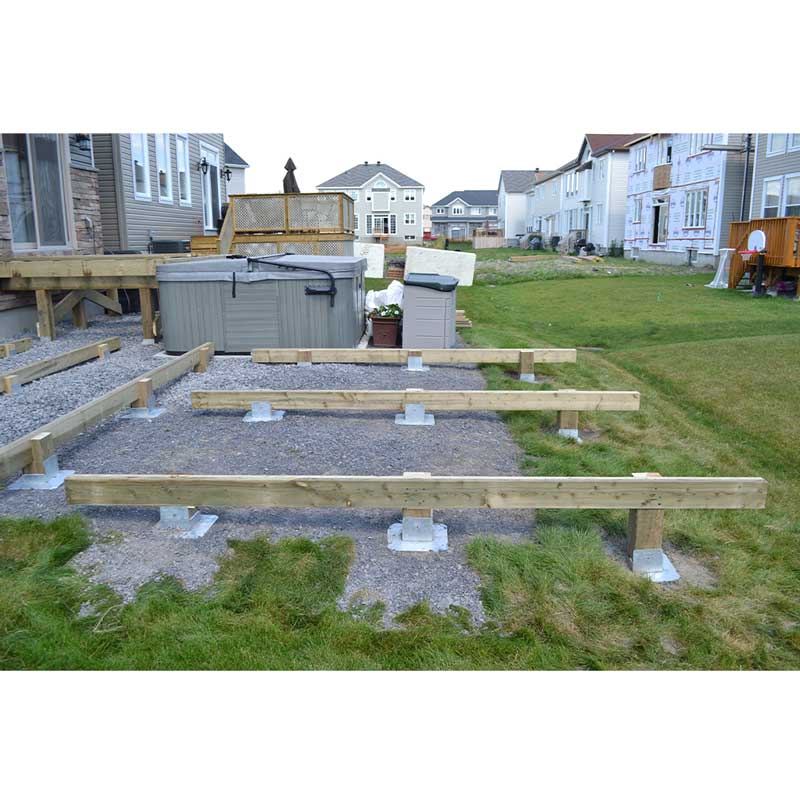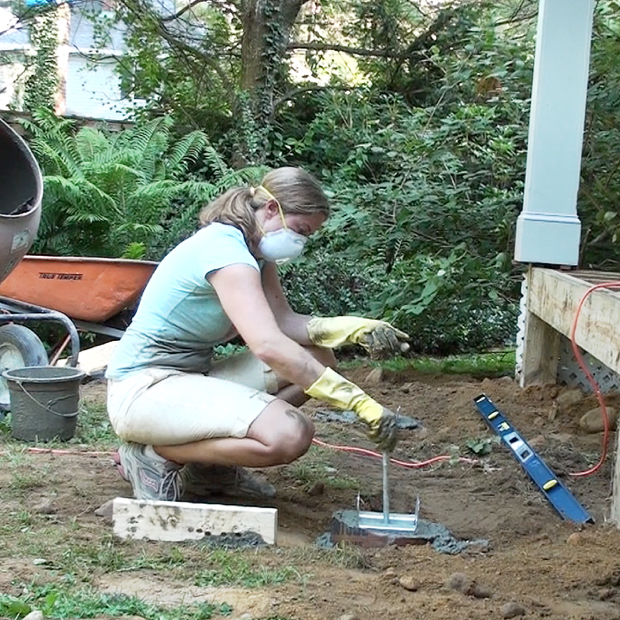Selecting the Right Deck Footings for Stability and Sturdiness
When it pertains to developing a deck, one of one of the most critical choices you will make is choosing the appropriate footings for stability and durability. The long life and safety and security of your deck depend heavily on the kind of grounds you choose, as they offer the vital support and security to hold up against the test of time. With a myriad of options available, it can be frustrating to identify which footings are best suited for your particular needs. In this conversation, we will certainly check out the different types of deck grounds, consider the vital elements to weigh when choosing, and delve right into the pros and cons of different alternatives. By the end, you will have a more clear understanding of the choices available and be better furnished to make an informed decision for your deck task.
Sorts Of Deck Footings
These footings consist of a round opening filled with concrete, which supplies a strong foundation for the deck posts. Concrete pier grounds are reasonably simple to install and use outstanding stability, making them a preferred selection for lots of deck jobs.
These grounds are mounted by screwing them right into the ground, which produces a safe and secure foundation for the deck. They also permit for very easy change and progressing of the deck if required.
Additionally, some home builders go with precast concrete grounds. These grounds are made from durable concrete and come in different sizes and shapes to suit different deck layouts. Precast concrete footings are hassle-free to install and offer a stable base for the deck structure.
Finally, an additional choice is the post-in-anchor ground system. This kind of footing includes driving a metal anchor right into the ground and connecting it to the deck post. It supplies versatility in terms of placing the deck messages and appropriates for decks with light-weight frameworks.
When picking the appropriate type of deck ground, it is important to think about aspects such as dirt problems, deck tons, and local structure codes (Deck Footings). Consulting with a professional service provider or architectural engineer can assist ensure the ideal ground is selected for a stable and risk-free deck
Factors to Think About When Picking Footings
When choosing the proper footings for a deck, it is vital to carefully think about numerous factors such as soil problems, deck load, and adherence to regional building ordinance. These elements play a significant duty in ensuring the security and resilience of the deck structure.
One of the primary elements to think about is the dirt problems. The kind of soil on which the deck will be constructed determines the kind of footings called for. As an example, decks improved sandy or loosened dirts may call for much deeper grounds to give adequate support and avoid settling. On the other hand, decks improved clay or expansive dirts might require grounds that can suit the soil's propensity to increase and contract.
One more essential element is the deck load. The weight of the deck, including the products utilized and any potential real-time lots such as furnishings or celebrations, must be taken into consideration when this article picking grounds. The footings have to websites be created to bear the weight of the deck and disperse it equally to protect against any type of architectural concerns or failings.
Lastly, adherence to neighborhood building regulations is vital. Building ordinance vary from area to area, and it is important to adhere to the certain requirements established by the local authorities. Deck Footings. These codes make certain that the deck is developed securely and satisfies the required standards for structural honesty and load-bearing capability
Concrete Grounds: Cons and pros

Concrete grounds supply several advantages and disadvantages when used as the structure for a deck. On the favorable side, concrete grounds give excellent stability and resilience.
One more advantage of concrete footings is their flexibility. They can be poured into different sizes and shapes to fit different deck styles and setups. Concrete footings can be tailored to fit the specific requirements and needs of the deck structure.
Nevertheless, there are additionally some drawbacks to making use of concrete grounds. One major negative aspect is the expense and labor involved in their installation. Concrete footings need excavation and frequently require the assistance of hefty equipment. This can enhance the overall expense of the deck task and might require expert help.

Helical Piers Vs. Sonotubes: Which Is Better?
In taking into consideration the structure choices for a deck, the comparison between helical piers and sonotubes is essential in determining the superior selection. They are turned into the ground using hydraulic equipment, giving a steady and long lasting structure for the deck.
The helical plates on the piers develop a strong grasp with the soil, preventing any movement or moving of the deck. Sonotubes, on the other hand, count entirely on the concrete loading for security, which may not provide the very same level of stamina and resistance.
In regards to setup, helical piers are fairly much easier and faster to mount contrasted to sonotubes. The hydraulic machinery made use of to twist the piers right into the ground makes certain a fast and efficient procedure. Sonotubes, on the various other hand, require digging openings and putting concrete, which can be time-consuming and labor-intensive.
In addition, helical piers are an weblink even more versatile alternative. They can be made use of in different dirt problems and can be adjusted or strengthened if required. Sonotubes, on the various other hand, may require extra assistance, such as rebar, in particular dirt conditions or areas with high tons demands.
Picking the Right Footings for Your Deck's Measurements
For optimal structural integrity, it is vital to meticulously select the ideal grounds that align with the dimensions of your deck. The dimensions of your deck, including its length, size, and height, play a substantial duty in determining the kind and dimension of footings required.
When picking footings for your deck, it is vital to think about the load-bearing capability of the dirt. The weight of the deck, combined with the weight of any kind of furniture or individuals on it, exerts a significant force on the footings (Deck Footings). It is critical to pick grounds that can adequately sustain this weight without sinking or moving over time.
Larger decks with higher measurements call for larger grounds to supply sufficient security and support. The shape of the grounds, whether they are rounded or square, depends on the layout and design of the deck.
Verdict
In final thought, picking the ideal deck grounds is crucial for making sure security and durability. Elements such as the type of grounds, the deck's measurements, and the pros and disadvantages of various alternatives should be considered.
These footings consist of a cylindrical hole filled up with concrete, which supplies a strong structure for the deck posts. Concrete pier grounds are reasonably easy to install and offer superb stability, making them a prominent option for numerous deck jobs.
Precast concrete footings are convenient to set up and offer a steady base for the deck structure.
It offers adaptability in terms of placing the deck messages and is ideal for decks with lightweight structures.
Concrete grounds supply numerous benefits and downsides when utilized as the foundation for a deck.